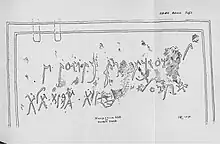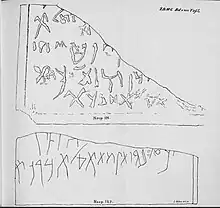Wilmanns Neopunic inscriptions
The Wilmanns Neopunic inscriptions are five Neopunic inscriptions discovered in 1873–74 in Ottoman Tunisia by Gustav Heinrich Wilmanns and published in 1876 by Julius Euting.[1]

Henchir Brigitta inscription, KAI 142, Neo-Punic 123
_inscription%252C_KAI_159%252C_Neo-Punic_124%252C_from_the_Gustav_Heinrich_Wilmanns_inscriptions_published_by_Julius_Euting_in_1876_02.jpg.webp)
Altiburus (Henchir Medeina) inscription, KAI 159, Neo-Punic 124

Bordj Helal inscription, KAI 139, Neo-Punic 125

Neo-Punic 126 and 127
The first three are known as KAI 139, 142 and 159. The numbering used by Euting (123-127) followed from his 1871 publication Punischen Steinen.
The inscriptions
The Henchir Brigitta inscription, a bilingual Latin-Neopunic inscription, also known as KAI 142, NSI 53 and NE 435,2, is in the Vorderasiatisches Museum Berlin.
The Altiburus (Henchir Medeina) inscription, KAI 159, NSI 55 and NE 437a, is in the Louvre (AO 5106).[2]
The Bordj Helal inscription, KAI 139, is also in the Louvre (AO 5144). It is bilingual with Berber inscription.[3]
Bibliography
- Bron F., Notes sur les inscriptions néo-puniques de Henchir Medeina (Althiburos), Journal of Semitic Studies 54, 2009, 141-147
- Xella P., Tahar M., Les inscriptions puniques et néopuniques d'Althiburos. Présentation préliminaire, RSF 42, 2014, 123-126
- Sznycer, Maurice, « Le texte néopunique de la bilingue de Bordj Hellal », Semitica, 27, 1977, p. 47-57, p. 47-57, pl. VII et IX
References
- Julius Euting, 1876 Inschriftliche Mittheilungen, Zeitschrift der Deutschen Morgenländischen Gesellschaft 29: 235-40: "Prof. Wilmanns dahier hat von seiner 1873/74 in der Regentschaft Tunis ausgeführten Reise unter der reichen wissenschaftlichen Ausbeute auch eine Anzahl carthagischer und 5 neupunische Inschriften in Abklatschen mitgebracht. Die letzteren bezeichne ich im Anschluss an die Zählung bei Schröder, und in meinen „Punischen Steinen" mit den Numern 123-127."
- AO 5106
- AO 5144
This article is issued from Wikipedia. The text is licensed under Creative Commons - Attribution - Sharealike. Additional terms may apply for the media files.